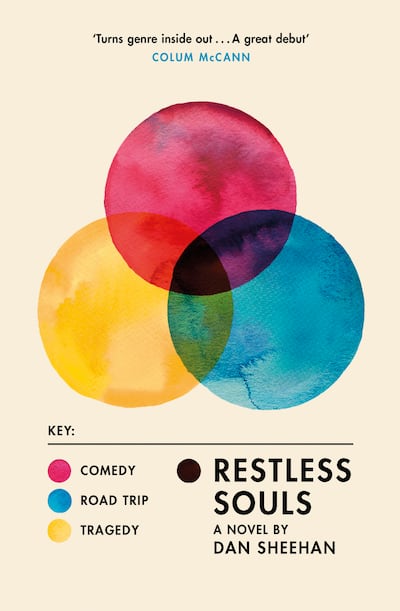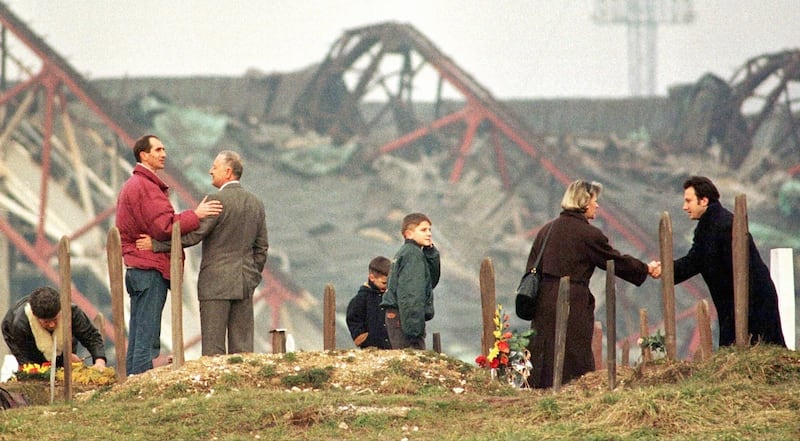
When I began work on Restless Souls in the summer of 2013, there were two images that I couldn't shake from my mind. The first was of a beautiful Neo-Moorish library burning on the banks of a river, the ashes from its millions of volumes drifting through the night air like snow. The second was of a heavily tattooed man hanging from the goalposts of a football pitch in the twilight, his young life extinguished by his own hand.
Restless Souls is the story of Karl and Baz – two young, woefully unqualified and unprepared Dublin men – who embark on a journey to an experimental PSTD clinic on the central Californian coast in a last-ditch effort to save their childhood friend Tom from the ravages of his war-damaged psyche. It's also the story of a city's survival and resilience, and of the friendships and love affairs that can still bloom amid devastation.
The research and writing of the novel brought me to Joshua Tree National Park, an eerie desert landscape teeming with humanoid yucca trees and ancient rock formations; it took me west, to San Simeon, California, where cars wind perilously around the cliff edges of the Pacific Coast Highway and gargantuan elephant seals roar and wrestle in the sand dunes; and it led me back to Sarajevo – the minaret-silhouetted Bosnian capital with whose culture, history, and people I have fallen in love.
For 1,425 days, from the spring of 1992 to the winter of 1995/96, the citizenry and infrastructure of Sarajevo – a place once commonly referred to as the “Jerusalem of Europe” for its centuries-long reputation as a hub of cultural and religious diversity – suffered through a sustained daily barrage of shelling and sniper fire in what was to become the longest siege in the history of modern warfare.
Television images from the Bosnian War of the early-to-mid-1990s have lingered in my mind like few others since. Despite the fact that dispatches from the Troubles – a conflict far closer to home – were still a regular segment on the Six One News back then, there was something about the footage from Bosnia, and from Sarajevo in particular, that I couldn’t shake when I was a child.

Perhaps it was the immediacy of the reports, the idea that war correspondents from across the globe had converged on the city not to cover the aftermath of a single horrific attack, but to detail its dreadful continuance. That the burning of a library full of irreplaceable Islamic texts or the booming of ordnance hitting a densely populated neighborhood or the awful beauty of tracer fire lighting up the night could serve as the backdrop to a news segment horrified me. Even then, there seemed to me to be an uneasy blending of concern and exploitation in seeking out such devastation. At what point, I began to wonder, does the act of bearing witness become an exercise in disaster tourism?
I visited Sarajevo as a teenager, years before beginning work on Restless Souls – ran my fingers across the bullet-holes that pockmarked the buildings, looked down from positions previously held by snipers and paramilitaries manning heavy artillery at the thousands of graves in the valley below – and found myself wrestling, albeit on a much more modest scale, with that dichotomy.
Primarily what I felt was sorrow at anyone having to withstand such a prolonged and relentless assault on everything and everyone they had ever known by those they had once called neighbours, and admiration for the Sarajevans’ resolve to rebuild and recover. But there was also an impulse beneath – a desire to hear details and statistics and visit the sites of the worst atrocities, to make an historical time capsule of a place still raw with grief – that I look back on with no small amount of shame.

Through Tom, the character who spends four years embedded within the besieged city, I wanted to explore this internal conflict. When, if ever, does the impulse to experience, by proxy, such extremity of suffering, evolve into something more clear-eyed and useful?
What Tom lives though during this period prompts the novel’s central quest: to find someone capable of dampening the memories that haunt him, before they completely overwhelm. That someone, they hope, is Dr Saunders – an eccentric Vietnam veteran whose experimental treatment promises a new lease on life for PTSD suffers. But as Karl and Baz try to save Tom from his memories, they must confront their own: of the suicide of Karl’s surrogate brother Gabriel, and the hole it has left in their lives.
There is no one of my generation in Ireland whose teens or twenties were not marked in some way by the suicide of a classmate, teammate, sibling or friend. I was fortunate enough not to lose someone close to me this way, but have witnessed the damage to those who did. I wanted to try, as best I could, to convey a sense of what happens to the people left behind, how a group can fracture in the wake of such a tragedy. For narrator Karl, the death of his brother, and the grief and guilt and anger that follow, become almost paralysing, colouring every aspect of his life, every decision he makes or is unable to make.
This is a novel about the trauma of survival; about war and loss and regret; about the power of memory to debilitate and destroy, as well as soothe, in times of hardship; about the things we choose to hold on to and the things we need to let go. Above all, it's a book about male friendship. Though the subject matter may be bleak, I wanted these men's journey to be told with as much humour as sorrow, as much joyful abandon as resigned despair. Time and circumstances may have stolen away the invincibility of youth from Karl, Tom, and Baz, but theirs is a makeshift family as nourishing and as vital as any bound together by blood.
Restless Souls by Dan Sheehan is published in trade paperback by Weidenfeld and Nicolson, at £16.99. It is launched in the Gutter Bookshop, Temple Bar, Dublin tonight, at 6.30pm, and is reviewed in The Irish Times this Saturday
















